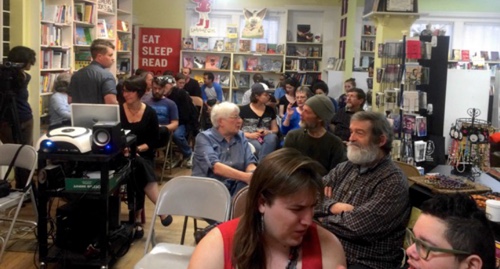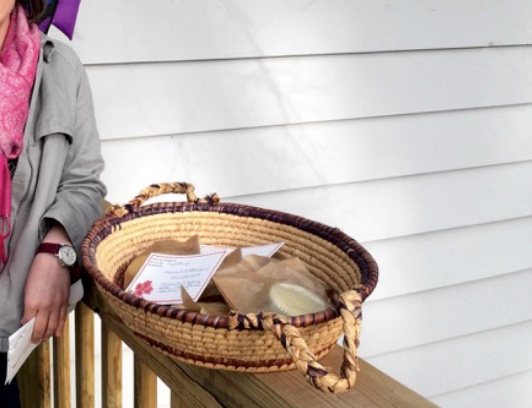Doing Public History: This Is What Success Can Look Like

Tearing Down Oakhurst, Charis Books and More, Atlanta, Ga., March 10, 2014.
Sometimes it takes just a short time to have an impact.
In March 2014 I presented a program about gentrification in an Atlanta, Ga., suburb. During the discussion, a woman who lived in the neighborhood raised her hand and shared her story of how gentrification has affected her. She told the audience about her new plan to push back against those impacts one bar of homemade deodorant at a time. She called it her “Hi, hey there” project. More about the deodorant in a moment.
Susan (a pseudonym) is a schoolteacher and graduate student who moved to Decatur to work in the city’s school system. She’s a white 30-something West Coast suburban transplant. Unable to buy a Decatur home, she rented an apartment above a garage in the city’s gentrifying Oakhurst neighborhood. It was close to school and to work, affordable, and pet-friendly.
“Why do I live here,” Susan said when I interviewed her a year ago. “I needed someplace with character and I think this place has some character. I needed a place I felt safe. I needed a place that was within 20 minutes of any place I had to go. I needed a place within my financial range.”
Susan has worked in Africa and with Atlanta’s refugee communities. Her graduate work includes a hefty dose of social sciences; she is intimate with the anthropological “Other” and she has experience working with the Other and as the Other. In early 2014, Susan realized that the boundaries that separated her academic and professional worlds and her personal life were not as rigid as she believed.
At the March 2014 program, Susan recounted how she realized that her neighborhood was changing. It happened after her dog died. The only neighbors who seemed to notice, according to Susan, were African American residents who have lived in the neighborhood since the 1960s. They were the only ones who asked where the once-familiar dog was and how Susan was doing as she walked along her street where new McMansions were replacing small early twentieth century cottages. Young, mostly white middle class families typically bought the McMansions, while older, longtime residents – post-white-flight black families and first-wave gentrifiers – lived in the smaller, more modest homes.
“I met a man at the beer garden and he lived in a house next door to a McMansion and he said – that was the first time I heard the word gentrification,” Susan explained while we were sitting in her apartment’s living room one week after the Atlanta gentrification program. “He said now we’re just at a white on white gentrification in Oakhurst.” She added, “I didn’t really know what gentrification was at that point. But that was the beginning.”
A few days before I interviewed her, a builder had demolished a 1,452 square-foot home across the street to build a new 2,750-square-foot house with four bedrooms, three baths, and the “Finest craftsmanship and attention to detail,” according to real estate websites advertising the property. An elderly African American widow home had occupied the old and the builder bought it for $302,500; the new home one year later sold for $749,500. It was one of 123 homes demolished between October 2011 and November 2014 and the construction site is a daily reminder of the rapid change underway in the neighborhood.
Susan recalled that she next thought about gentrification after reading something on the neighborhood’s email list. “And then I heard about your documentary on the listserv,” she said. I’ve done a documentary about gentrification. It was screened at the March meeting.
Discussion of the documentary prompted Susan to revisit the circumstances surrounding her dog’s death several months earlier. “Time is passing and in the last couple of months I noticed, you know, people don’t really say ‘Hi.’ People don’t really look at me much when I walk by,” Susan said. “Like why doesn’t anybody ask about my dog? When [neighbors] walk with their three dogs and somebody’s missing, I ask, ‘Uh oh, where’s the other one’?”
I asked Susan what impact that realization had upon her views of the neighborhood where she lived.
“God, they really don’t care about me. Like people I used to chitty-chat with I thought they knew I cared about them. Like they obviously don’t seem to care much about me,” Susan explained. “And then I started to learn more about gentrification and – well I had removed myself from the reality of ever being a homeowner here because I’m a teacher. I’ll never be able to buy a home here. I know that.”
And then she had another thought: “If I feel that people can’t really make eye contact with me and can’t say hi to me, how do people that don’t look like them feel when they walk by? How does a black person feel when they walk by them?”
Susan, who grew up in a multicultural community and who struggles with Southern culture shock, thought the situation stunk. So what did she do? She made some organic deodorant bars, packaged them with a personal message, put them in a basket, and steeled herself. “I decided that I was just going to kill them with kindness and say Hi,” she said.

Susan with a basket of her “Hi hey there” cards and deodorants, March 19, 2014.
Susan’s “Hi, hey there” campaign includes a smile, the greeting, and some deodorant: “And I have a little recipe card with my name and my phone number – not my email – and the ingredients of the deodorant and I’m introducing myself to people.”
Within six months, Susan moved away from Oakhurst. “I'm leaving the apt. [M]y time is up. Can't do garage living any more. And, what have I learned? Rents up TOO high to stay,” Susan wrote to me on Facebook late in 2014. “I learned so much about life from your documentary – I will always be grateful. I will miss my neighbors so much[,] so much!”
There probably is no way to effectively gauge the impacts of my research and writing on gentrification in Decatur. Public policy there has not changed. Displacement and teardowns continue briskly more than three years after I documented the demolition of a former urban homesteader’s small house. The city demolished its last intact African American heritage sites. Its 2009 whites-only historic resources survey has not been amended or addressed by city officials. Many Decatur residents still resent the fact that I began asking difficult questions about them and their city.
But for folks like Susan and other Decaturites who paused to ask their own difficult questions, public history and advocacy found their marks and to me, like Susan’s deodorants, that’s the sweet smell of success.